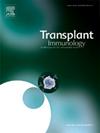雷帕霉素修饰的CD169low/-tolDC通过IL-10+Breg促进小鼠植皮存活。
IF 1.4
4区 医学
Q4 IMMUNOLOGY
引用次数: 0
摘要
由于同种异体皮肤具有较高的免疫原性,因此容易发生排斥反应。通过实现免疫耐受,可以延长同种异体皮肤移植物的长期生存,而不需要免疫抑制剂或只有短期低剂量依赖。耐受性树突状细胞(toldc)具有很强的移植物耐受性。我们探索了雷帕霉素修饰的CD169low/- toldc调控白细胞介素-10 (IL-10) B调节性(IL-10+ Breg)细胞生成并介导小鼠同种异体皮肤移植长期存活的机制。用低剂量GM-CSF处理间充质干细胞(MSC)来源的树突状细胞后,通过流式细胞术分类获得CD169low/- toldc。采用术前刺激+术后过继输注CD169low/- toldc的治疗方案治疗急性排斥(AR)小鼠皮肤移植模型-过继输注组。对照组给予等量生理盐水。评估生存率和移植排斥率。采用混合淋巴细胞培养、流式细胞术、免疫组织化学(IHC)和western blotting (WB)技术,研究了过继性输注小鼠不同IL-10+ Breg亚群的表达,以及CD169low/- toldc诱导IL-10+ Breg产生介导耐受的分子机制。过继输注CD169low/-tol dc可显著延长小鼠皮肤移植后的排斥反应时间,促进移植物存活。移植皮肤局部血流信号显著增加,伴有轻度局部炎症。流式细胞术分析显示,体内IL-10+ Breg的高表达与Foxp3+ treg的变化呈正相关,主要富集在CD19 + CD24 + CD27+ mBreg和CD19 + CD23 + CD27-CD24+ Breg亚群中,IgM表达水平较高。与对照小鼠相比,观察到显著差异。发现CD79b/NF-κB通路参与Breg的产生。与对照组相比,过继输液组CD24、CD23、CD79、BTK、NF-κB p50/p65、CD40、IKKα水平均显著升高。过继输注CD169low/-MSCs/ toldc可通过CD79/ btk依赖性和CD40/ ikk α非依赖性途径激活NF-κB通路,诱导IL-10 + Breg高表达,促进小鼠皮肤移植移植物存活。本文章由计算机程序翻译,如有差异,请以英文原文为准。
Rapamycin-modified CD169low/-tolDC promotes skin graft survival in mice via IL-10+Breg
Skin allografts are prone to rejection because of their high immunogenicity. By achieving immune tolerance, the long-term survival of skin allografts can be extended without the need for immunosuppressants or with only short-term low-dose dependency. Tolerogenic dendritic cells (tolDCs) show a strong potential for graft tolerance. We explored the mechanism whereby rapamycin-modified CD169low/-tolDCs regulate interleukin-10 (IL-10) B regulatory (IL-10+ Breg) cell production and mediate the long-term survival of skin allografts in mice. CD169low/-tolDCs were obtained through flow cytometry sorting after treating the mesenchymal stem cell (MSC)-derived dendritic cells with a low dose of GM-CSF. A treatment regimen combining preoperative stimulation and postoperative adoptive infusion of CD169low/-tolDCs was used to treat an acute rejection (AR) mouse skin transplantation model—the adoptive infusion group. An equivalent dose of saline was administered to the control group. Survival and graft rejection rates were assessed. Mixed lymphocyte culture, flow cytometry, immunohistochemistry (IHC), and western blotting (WB) were used to elucidate the expression of different IL-10+ Breg subsets in mice treated with adoptive infusion therapy and the molecular mechanisms whereby CD169low/-tolDCs induce IL-10+ Breg production to mediate tolerance. Adoptive infusion of CD169low/−tol DCs markedly prolonged the rejection time after skin transplantation in mice and promoted graft survival. A significant increase was observed in local blood flow signals in the transplanted skin, along with mild local inflammation. Flow cytometric analysis revealed a positive correlation between high expression of IL-10+ Breg and the changes in Foxp3+ Tregs in vivo, primarily enriched in the CD19 + CD24 + CD27+ mBreg and CD19 + CD23 + CD27-CD24+ Breg subsets, with higher levels of IgM expression. Significant differences were observed compared with control mice. CD79b/NF-κB pathway was found to be involved in Breg production. CD24, CD23, CD79, BTK, NF-κB p50/p65, CD40, and IKKα levels in the adoptive infusion group were significantly increased compared with those in the control group. Adoptive infusion of CD169low/-MSCs/tolDCs may activate the NF-κB pathway through CD79/BTK-dependent and CD40/IKKα-independent pathways, inducing high expression of IL-10 + Breg and promoting graft survival of mouse skin transplantation.
求助全文
通过发布文献求助,成功后即可免费获取论文全文。
去求助
来源期刊

Transplant immunology
医学-免疫学
CiteScore
2.10
自引率
13.30%
发文量
198
审稿时长
48 days
期刊介绍:
Transplant Immunology will publish up-to-date information on all aspects of the broad field it encompasses. The journal will be directed at (basic) scientists, tissue typers, transplant physicians and surgeons, and research and data on all immunological aspects of organ-, tissue- and (haematopoietic) stem cell transplantation are of potential interest to the readers of Transplant Immunology. Original papers, Review articles and Hypotheses will be considered for publication and submitted manuscripts will be rapidly peer-reviewed and published. They will be judged on the basis of scientific merit, originality, timeliness and quality.
 求助内容:
求助内容: 应助结果提醒方式:
应助结果提醒方式:


